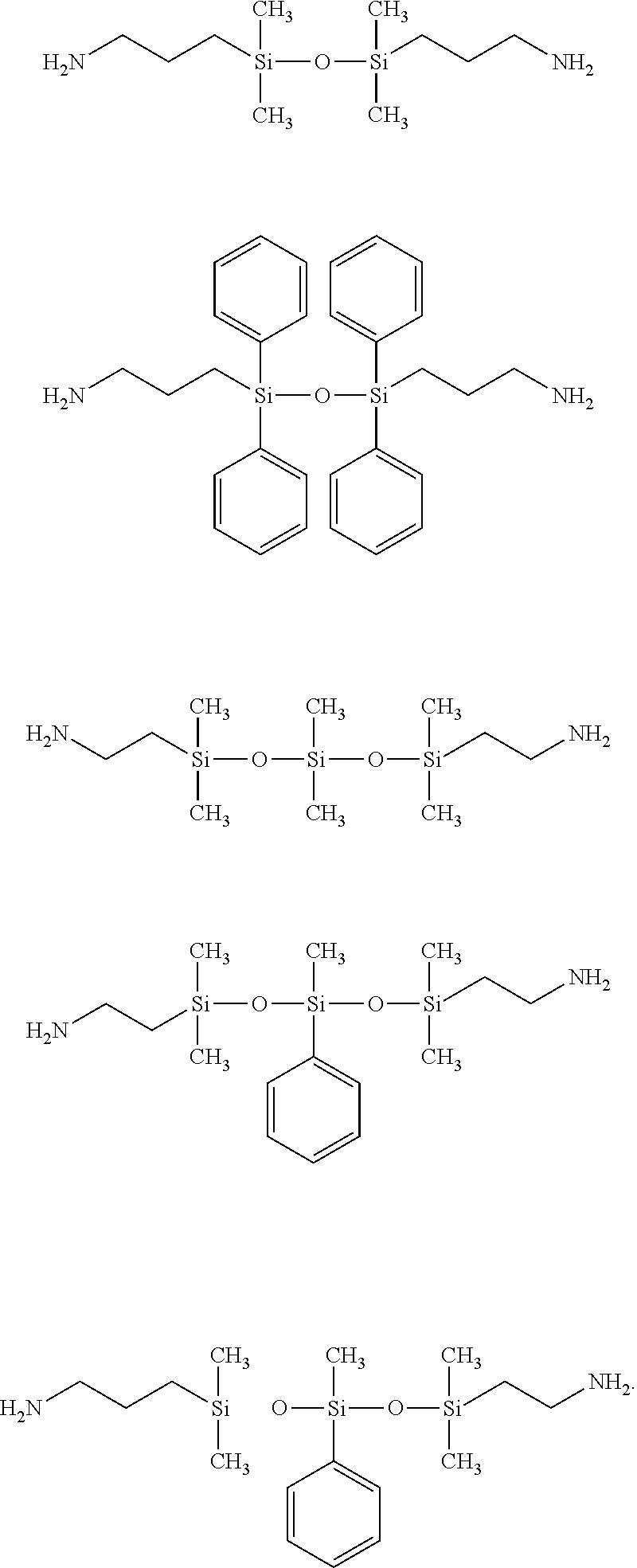Dielectric Film Forming Composition
a technology of dielectric films and compositions, applied in the direction of basic electric elements, electrical apparatus, solid-state devices, etc., can solve the problems of increasing the amount of filler, so as to reduce the effect of reducing the transparency of the film and reducing the amount of cte of the dielectric film
- Summary
- Abstract
- Description
- Claims
- Application Information
AI Technical Summary
Benefits of technology
Problems solved by technology
Method used
Image
Examples
synthesis example 1 (
P-1)
Preparation of 6FDA / DAPI Polyimide
[0110]
[0111]Solid 4,4′-(hexafluoroisopropylidene)bis(phthalic anhydride) (6FDA) (2.370 kg, 5.33 mole) was charged to a solution of 1-(4-aminophenyl)-1,3,3-trimethylindan-5-amine (also known as 4,4′-[1,4-phenylene-bis(1-methylethylidene)]bisaniline (DAPI)) (1.473 kg, 5.51 mole) in NMP (9.86 kg) at 25° C. The reaction temperature was increased to 40° C. and the mixture was allowed to react for 6 hours. Next, acetic anhydride (1.125 kg) and pyridine (0.219 kg) were added and the reaction temperature was increased to 100° C. and allowed to react for 12 hours.
[0112]The reaction mixture above was cooled to room temperature and transferred to a larger vessel equipped with a mechanical stirrer. The reaction solution was diluted with ethyl acetate and washed with water for one hour. After the stirring was stopped, the mixture was allowed to stand undisturbed. Once phase separation had occurred, the aqueous phase was removed. The organic phase was diluted...
formulation example 9
[0121]Formulation Example 9 (FE-9) was prepared by using 13.00 g of polymer (Poly-1), 27.36 g cyclopentanone, 31.20 g cyclohexanone, 1.73 g n-butanol, 0.65 g of methacryloxypropyl trimethoxysilane, 0.39 g of NCI-831, 2.60 g of titanium carboxyethyl acrylate, 7.80 g of surface treated silica, 13 g of tetraethylene glycol diacrylate (SR 268), 1.46 g of trimethylolpropane triacrylate, (SR 351LV), 0.78 g of 0.05% solution of Polyfox 6320 in cyclopentanone, and 0.03 g of p-benzoquinone. After being stirred mechanically for 24 hours, the formulation was used for the following tests.
process example 1
Lithography Process Example 1
[0122]The photosensitive FE-9 was spin coated on a silicon wafer and baked at 70° C. for 180 seconds using a hot plate to form a coating with a thickness of about 15 microns. The photosensitive polyimide film was exposed with a broadband UV exposure tool (Carl Süss MA-56) through a mask having a desired pattern for exposure. After the exposure, the exposed film was heated at 50° C. for 3 minutes.
[0123]After the post exposure bake, unexposed portions were removed by using cyclopentanone as a developer (2×75 seconds of development), followed by rinsing the developed film with PGMEA for 15 seconds to form a pattern. A resolution of 20 microns at a photospeed of 250 mJ / cm2 was achieved. Patterned features in the film exhibited an aspect ratio of 15 / 20 or 0.75.
Laser Ablation Process Example 1
[0124]FE-6 (Table 2) was spin coated on a silicon wafer and baked at 95° C. for 10 minutes using a hot plate to form a coating with a thickness of about 10.50 microns). T...
PUM
| Property | Measurement | Unit |
|---|---|---|
| particle size | aaaaa | aaaaa |
| optical transparency | aaaaa | aaaaa |
| optical transparency | aaaaa | aaaaa |
Abstract
Description
Claims
Application Information
 Login to View More
Login to View More - R&D
- Intellectual Property
- Life Sciences
- Materials
- Tech Scout
- Unparalleled Data Quality
- Higher Quality Content
- 60% Fewer Hallucinations
Browse by: Latest US Patents, China's latest patents, Technical Efficacy Thesaurus, Application Domain, Technology Topic, Popular Technical Reports.
© 2025 PatSnap. All rights reserved.Legal|Privacy policy|Modern Slavery Act Transparency Statement|Sitemap|About US| Contact US: help@patsnap.com



